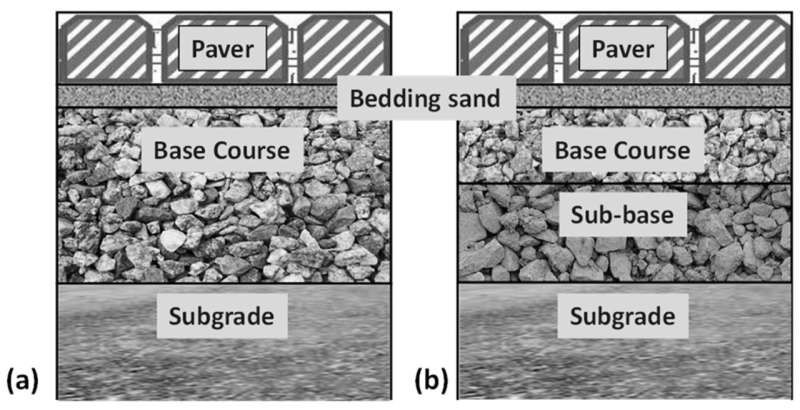Typical permeable pavement configuration: (a) pavement containing only a granular base course, (b) pavement containing granular base and sub-base courses. Credit: Sustainability (2022). DOI: 10.3390/su14094970
This year has seen one of Australia's worst flood disasters on record in the eastern states, with 23 people killed, thousands left homeless, and a damage bill expected to top $1.5 billion.
Climate change aside, increasing urban development is escalating the potential flood risks and adding to the likelihood of a projected $10 billion hole in the economy by 2050 unless urgent action is taken.
University of South Australia engineers have proposed one flood control measure in a new study that recommends designing permeable pavements to specifically suit local rainfall and soil conditions and reduce flood impacts.
Permeable pavements are used on many driveways, carparks and roads (excluding main arterial roads and motorways) and typically consist of permeable pavers laid on an upper bedding layer of between 2–6 millimeters of gravel under which lies a base course layer above natural soil.
They are designed to allow rainfall to infiltrate through their surface, storing water in the base course for later reuse, and reducing urban flooding by up to 50 percent. However, their success is variable, depending on rainfall intensity, soil type and pavement thickness.
UniSA engineers collected data from 107 towns and cities across Australia, designing an optimal permeable pavement system based on a five percent probability of excess rainfall and a storm duration of 30 minutes.
They built an algorithm to determine the dominant soil types (clay, silt, sand or gravel) for each locality, which infiltrate water at different rates. Sand and gravel are highly permeable, for instance, whereas clay soil has a low permeability.
UniSA Professor in Geotechnical Engineering, Mizanur Rahman, says the design proposal is based on pavements storing 70 percent of the water in the base course layer, with only 30 percent released as stormwater runoff.
"Our study shows that this is possible if the base course layer in permeable pavements is suitable for local conditions, taking into account the soil type and rainfall intensity," Prof Rahman says.
"The pavement needs to be thicker if the rainfall intensity is higher or the soil is less permeable. For highly permeable soils, the amount of rainfall is less significant.
"Likewise, a region like Adelaide is characterized by clayey soils, but low rainfall, so the permeable pavement often only needs a minimum base course thickness."
At least one third of Australian towns and cities fall in low to moderate rainfall areas, requiring no more than a 100mm base course layer on most of their road surfaces. However, the north-east of the country has both clayey soils and intense rainfall, requiring much thicker permeable pavements to reduce the stormwater runoff.
Many councils across Australia are already installing permeable footpaths, significantly reducing stormwater runoff to the roads, as well as storing water to support roadside watering of trees.
Prof Rahman says by integrating permeable surfaces on both roads and footpaths, it would markedly reduce stormwater loads and mitigate flooding.
"We are hoping to extend our design to commercial and industrial pavements, and to continue our work harvesting water using permeable pavements for watering roadside gardens.
"Our preliminary research shows that the carbon footprint generated in a car park could potentially be neutralized in 15 years by growing trees with harvested water. Our next step is to improve water quality using permeable pavements."
The study is published in the journal Sustainability.
More information: Asif Iqbal et al, Permeable Pavements for Flood Control in Australia: Spatial Analysis of Pavement Design Considering Rainfall and Soil Data, Sustainability (2022). DOI: 10.3390/su14094970
Provided by University of South Australia
























